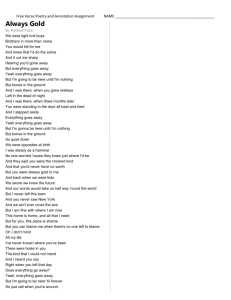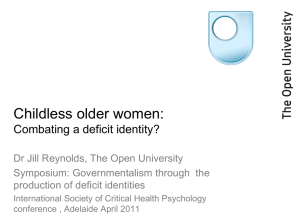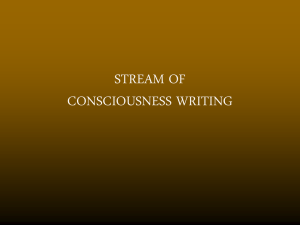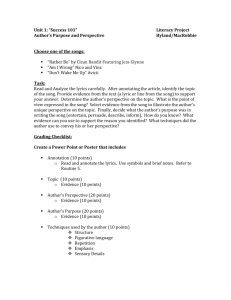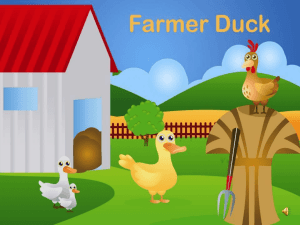Virginia`s Early Screening Tool, Part 2
advertisement
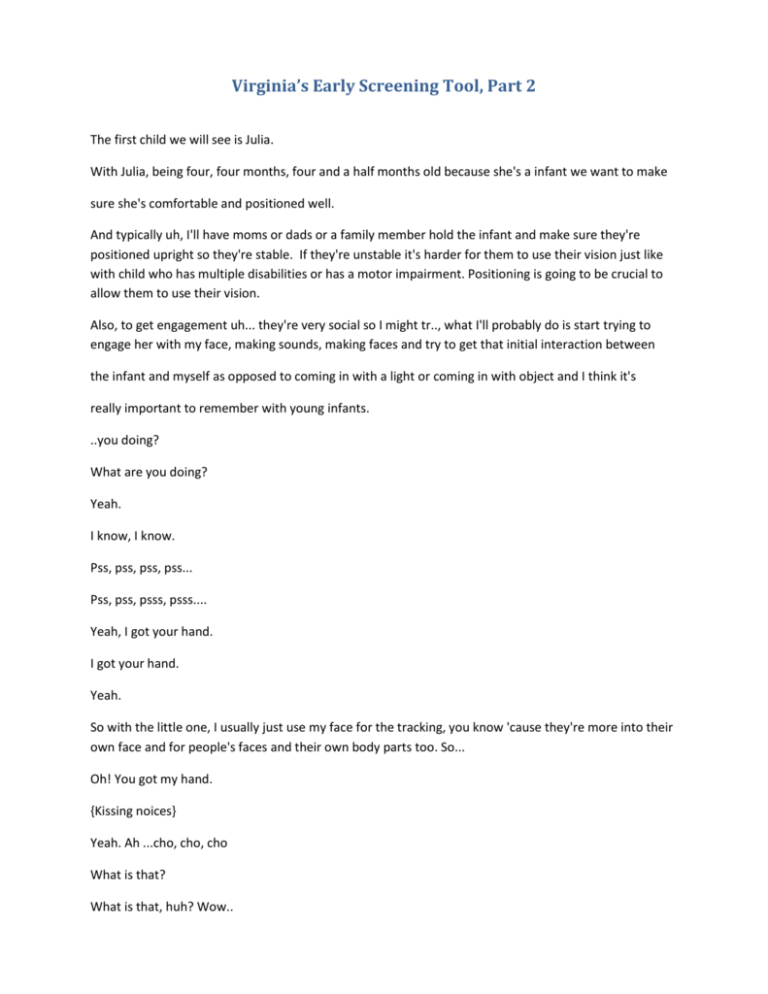
Virginia’s Early Screening Tool, Part 2
The first child we will see is Julia.
With Julia, being four, four months, four and a half months old because she's a infant we want to make
sure she's comfortable and positioned well.
And typically uh, I'll have moms or dads or a family member hold the infant and make sure they're
positioned upright so they're stable. If they're unstable it's harder for them to use their vision just like
with child who has multiple disabilities or has a motor impairment. Positioning is going to be crucial to
allow them to use their vision.
Also, to get engagement uh... they're very social so I might tr.., what I'll probably do is start trying to
engage her with my face, making sounds, making faces and try to get that initial interaction between
the infant and myself as opposed to coming in with a light or coming in with object and I think it's
really important to remember with young infants.
..you doing?
What are you doing?
Yeah.
I know, I know.
Pss, pss, pss, pss...
Pss, pss, psss, psss....
Yeah, I got your hand.
I got your hand.
Yeah.
So with the little one, I usually just use my face for the tracking, you know 'cause they're more into their
own face and for people's faces and their own body parts too. So...
Oh! You got my hand.
{Kissing noices}
Yeah. Ah ...cho, cho, cho
What is that?
What is that, huh? Wow..
Yeah..Wow, pretty good.
Where did it go?
Ahh, where did it go?
Opps! There it went.
At four and a half months we wouldn't expect convergence yet. Let's see what you do.
[Tongue smacking noises]
Here it comes.
[Kissing noises]
Ohh! What was that?
What was that?
[Kissing noises]
Boom!
Ah! What was that? Yeah.
And for the papillary response, instead of shining something in her eyes I would just block her eyes and
then have the light..just the natural light.
Yeah.
You can do that with just the natural. You already constricted from that bright light, aren't you?
Yes, you are.
Yes, you are.
Yeah, I know.
[Tongue smacking sounds]
Those your feets?
Are those you feet?
Huh? Ah, what is that? Ah!
Very good! Look at that.
Nice. Ah, very nice.
Yeah. It's very nice.
Very nice.
There's those feet..
[tounge smacking]
[baby coughing]
Oh! Oh, oh, oh.
Oh, oh, oh. Oh, oh, oh.
Oh, oh, oh.
Say peak-a-boo.
Peak.
Peak-a-boo.
Peak-a-boo.
[muffled]
She's so good-natured.
Peak-a-boo.
[Baby coos]
Dr. Brown: Oh! Does she want to get out?
Mom: She wants to sit up.
Dr. Brown: You wanna to sit up?
Is that what you're trying to do?
Say I'm trying to sit up.
Say I'm trying to sit up. Yeah.
[Baby coos]
Oooh! Yeah.
Say I'm trying to sit up.
What else you got to say?
What else you got to say? Okay.
[baby fusses]
Is she.... Do you want to sit her up?
Oh yes, I know.
I know.
[baby sneezes]
Whew!
[baby sneezes]
Bless You!
Yes! Are you going to sit up?
What a lucky baby!
Yeah!
[baby coos]
Mom: Yeah!
Dr. Brown: She's beautiful.
Hey! There you are.
There you are.
Wow! Look at that.
Has mama been working you out, huh?
Huh? Has mama been working..
Look at that.
[Tongue clicking sounds]
I don't know.
I think we got every,
just about everything we need.
Yeah, I think we got everything we need.
Yeah.
Ah! Look at this, such a big girl.
[Tongue clicking sounds]
[Kissing sounds]
Dr. Brown: There's mama.
Mom: Hi!
Dr. Brown: There's mama.
There's mama.
[Tongue clicking sounds]
There we go.
That's good.
It shows that, you know, still the eyes at this age, you wouldn't expect the eyes to be you know, working
together well until she's about six months. So that shows a demonstration at one whole eye training, but
that's just typical. Say I haven't gotten it all together yet, huh?
Yeah.
[baby coos]
Oh, I know.
Well, I think that's it. We looked at, um...
Yes. Hi.
We looked at um..... ...responding to the light. We wouldn't expect her eyes to be lined up. And actually,
you can see the light. Let me see what she looks like with the light in her eyes.
[Tongue clicking sounds]
Oh, I know, I know.
[Baby starts to cry]
Aw. Yeah.
Do you need a momma... do you need a mommy break?
Go ahead, go ahead.
Ah!
There. Is that better?
Is that better? Huh?
We'll do one more thing. I hope it's ok.
Okay?
[baby fuses]
Yeah, I know.
We can be done.
We can be done.
[flash light turns on]
Oh, What is that?
Say oh. It's so bright. I'm so sorry.
Is that too bright?
[baby fusses]
Okay we can be done.
My goodness.
My goodness it's so nice.
Say oh.
What is that?
Where did it go?
[Kissing sounds]
Yes, what a sweet girl.
Ah!
[Kissing sounds]
What you say? Want to do peak-a-boo?
Say.
Ready? One, two, three.
Peak-a-boo.
Oh!
There you are.
I saw it!
Ready?
Ready? One, two, three
Peak-a-boo.
Oh.
[baby coos]
Oh.
Julia is four and a half months old and so because she's younger than six months, there's a couple things
that we wouldn't be expecting her to exhibit. One is, at that age, we're not expecting children to have
full conversions. Meaning that when I brought an object close to her nose, I really wasn't expecting to
see her eyes come in evenly to watch that. That is you don't usually see that behavior until six months
and older. So even though she wasn't showing us conversions that's very age appropriate. Another thing
with Julia is in the early items of blinking to light and looking at how she responds to light. That's a very
aversive to some children, especially with infants, and I don't like to usually shine a bright light in their
eyes. So with her, to look at papillary response, I played a peek a boo game. And I was able to cover her
eyes and try to see if I could get, uh, you know, long enough for her, to have the eyes become
accustomed to being in a dark area. Then take my hand away to see if the natural light in the room
would be enough to see if we had a papillary response, where the pupil got smaller because of the light.
And that did work, so that was that, uh uh, that was a nice way of testing that behavior. By six months
she wouldn't have the behaviors we would be expecting by six months of age, so on the vision screening
we would look at the behavior observations by three months of age to make sure she exhibited all
those.
Um... she looks at someone's face and tracks with head and eyes together. And he usually with young
infants, I do use my face. Children who were that young are more interested in faces, their own body,
then objects. And mom was close by. A lot times moms need to hold babies because sometimes they are
uncomfortable.
Uh... in unfamiliar places unless you're in their home testing them. So, she was able to track and if you
noticed when I was moving my head, she had to move her head and eyes together, which is really age
appropriate. We wouldn't expect her to be able to isolate her eyes from her head, yet.
Uh..she smiles at others. I checked with mom. She did give me a smile, brief smile. Uh... and watch his
own hands is another behavior that you seeing young infants. When they first discover they have any
hands and they will continue to look at them and be amazed at those, so that's part of their body.
Probably at four and a half months, she's already moved through that uh... but she did show all the
typical, ah, observations or behaviors that I would expect in a child her age.
When I was working with Julia, I noticed that on her left, I believe, there was a little cresting. Uh, and it
seem that there was uh... you know something going on with the tear duct. And after talking to her
mom after the evaluation, we found out that she does have a tear duct that is blocked and she's been
working with your pediatrician to work on that. So that's what we were seen on that left eye.
